#józef poniatowski's children
Text
Józef Poniatowski’s children and descendants
Because a couple of months ago there’s been a discussion about Napoleon marshal’s children I decided I out to share with you the info about Józef Poniatowski’s issues and descendance.

Though never married, prince Józef nevertheless had two illegitimate sons.
The oldest one was Józef Szczęsny Mauricy Chmielnicki, born on the 17th of September, 1791.
The mother of the boy was most probably Poniatowski’s mistress of that time, the actress named Małgorzata Magdalena Wiktoria “Zelia” Sitańska (though there are as well versions it might have been another woman, for example, Zelia’s step-mother, also an actress - more on the topic I wrote here)
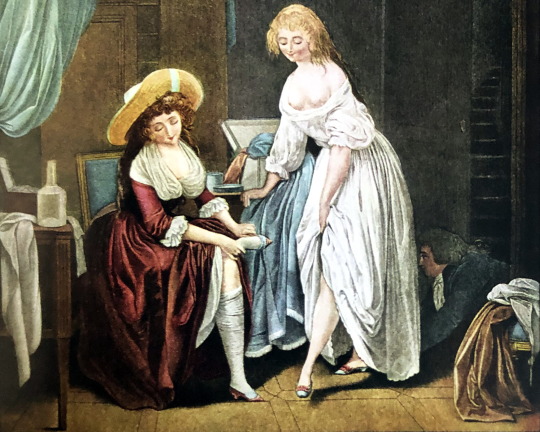
Zelia and here step-mother, a colored engraving
As for the fate of the boy - in his youth (before 1807) he started a military career in the Army of... Austria. Most probably it was prince Józef himself who arranged it, because his career started in the Austrian army too. (Another question is why Poniatowski didn’t “transfer” his son into the Army of the Duchy of Warsaw after the latter had been created, but, I’m afraid, we’ll never know the answer.)
And when in 1809 Austria attacked the freshly created Duchy, Józef Chmielnicki took part in the war... on the side of the Austrians. (And his father kinda accepted this, because in his will written 3 years later, in 1812, Poniatowski mentioned not only his firstborn but as well the fact that the latter was an officer in the Austrian Army.)
Chmielnicki fought as well in the next coalition wars, in 1812-1815 (against Napoleon as well), in 1831 he fought in defense of the Roman ecclesiastical state against local insurgents; for this he received the papal Order of St. Gregory. He also had the Austrian Military Cross. In 1856 he retired with the rank of colonel. He died unmarried in Vienna in 1860.
Unfortunately, I wasn’t able to find any image of Józef Chmielnicki, but in his military service records there is a little bit on his appearance:
Tall, of good health, very lively temperament and honest and reliable character. Polite and tidy; sometimes a bit violent and not always consistent. Zealous and active, with a special penchant for service in rifle units. He was wounded twice. He is fluent in German and Polish in speech and writing, speaks French and a little Italian. A very good staff officer, suitable for a regiment commander.
More do we know about Prince’s Józef’s other son, who was born on the 18th of December, 1809 in Warsaw and was then was given the name Józef Karol Ponitycki.

Józef Peszka, Portrait of Józef Ponitycki, 1815
As for Józef the second mother - there are no doubts in it, it was prince Poniatowski’s another mistress, Zofia Czosnowska née Potocka (more about her - here).
Though Czosnowska was married, prince Józef acknowledged her child and mentioned him in his will.

A miniature showing Ponitycki at the age of ten
The boy’s mother, however, didn’t care for her child much. Having divorced her official husband she married again in 1815, then placed her son in the custody of his aunt, prince’s Józef sister countess Maria Teresa Tyszkiewicz.
In the 1821 countess Teresa became the boy's legal guardian (Czosnowska officially gave him up) and in 1828 adopted him, changing his surname from Ponitycki to Poniatowski and adding Maurycy (Maurice) as his third name, thus making the boy the namesake of her long-term love Charles Maurice de Talleyrand.
And a little bit before, in 1826, Józef the younger gained French citizenship, and at the age of 18 (1827) he volunteered to join the French army.
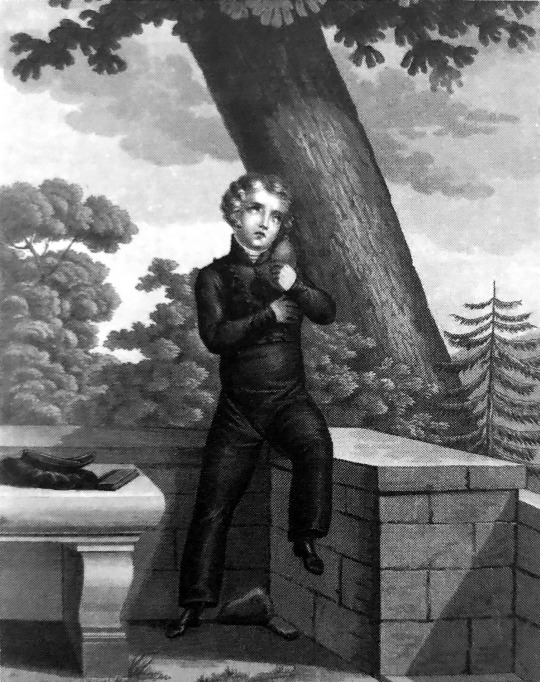
An anonymous painter, Prince Józef's son grieving after his father, 1820
The enlistment papers say that he was a healthy, blue-eyed, tall (1.79 m) blond, oval face, strong chin and aquiline nose. After graduating from school, he took part (as chasseur sergeant) in the Greek campaign in the Peloponnese (1829), later he was transferred to Algiers (1830), but he quickly returned to France.
During the July Revolution in Paris that year Poniatowski was among those soldiers who were putting it down, but when a year later the November Insurrection broke out in Poland he, together with his friend, Count of Montebello, a son of the Marshal Lannes, went to Poland to join the uprising. After the fall of the uprising, Józef returned through Galicia to France, where joined the rifle regiment as a captain and took part in the war in Algiers with Abd del-Kader in the years 1832-1836.

Józef Ponitycki-Poniatowski charges the camp of Emir Adb-el-Kader, a drawing by a French painter Eugène Chaperon
In 1839, driven by longing for his homeland, Poniatowski came to Kraków and made efforts to obtain permission to return to Warsaw. But the Russian Governor Paskevich refused him entrance and even tried (unsuccessfully) to confiscate) properties Józef inherited from his father and aunt.
Not being allowed to return to Poland, Poniatowski returned to France and to his regiment. He died on February 15, 1855 in Tlemcen, Algeria, and was buried there.
As for Józef Karol Poniatowski’s private life - in 1836 he married an Englishwoman, Maria Anna Semple. They have two children - a son, Józef Stanisław, born in 1837, and a daughter, Maria Teresa, a year younger.
Józef Stanisław joined the army at the age of 17 and went on the Crimean campaign. During the siege of Sevastopol, he was appointed lieutenant for his bravery. He then served in the cavalry regiment. He left the service due to ill health. In 1866 he married Léonide Marie Victoria Charner, the daughter of a French admiral, the chief commander of a sea expedition to China.
Six weeks after his marriage with Léonide Charner in 1866 he became mental ill. From 1880 until his death July 20, 1910 in Geel, Belgium, where he resided as a psychiatric patient in the wellknown Geel "Colonie des Aliénés''. (Many thanks to Werner for providing me with this information).
As for Józef Stanisław’s issue - there we have a kind of discrepancy. According the Polish sources like, for example, the Genealogy of the Descendants of the Great Sejm , he died childless but according his profile at geni.com he did have a son, named André whose descendants still live in the US. (The site doesn’t allow to see all the data but it is highly probably that the direct male line continues till our days.)
Maria Teresa, after the death of her father, was taken care of by the Duchess d'Eckmühl, the widow of the Marshal Davout. In 1859, Maria Teresa married Louis de Guirard, Comte de Montarnal, grandson of Marshal Ney. He was an official in the Ministry of Treasury. They had seven children: three sons and four daughters. But neither of those, according both the Genealogy of the Descendants of the Great Sejm and Geni.com had issue.
What’s more, according Geni.com Józef Karol Poniatowski after the death of his first wife married again. That time he took as a wife a woman named Elżbieta Fuchs, and they have a son named Wojciech Józef. That Józef, it looks like, was married, but no information about his issue is provided.
#Poniatowski#józef poniatowski#zelia sitańska#Józef Szczęsny Mauricy Chmielnicki#zofia czosnowska#Józef ponitycki#józef karol maurycy poniatowski#józef poniatowski's children#józef poniatowski's descendants#józef peszka#eugène chaperon
22 notes
·
View notes
Text
Royal Castle Warsaw – Top Attraction in Warsaw
The Royal Castle in Warsaw is a baroque-classicist residence, the former house of many Polish monarchs and kings. Nowadays it performs museum and representative functions. Originally it was the residence of the Dukes of Mazovia, and since the 16th century, it was the seat of the authorities of the First Polish Republic: the King and the Parliament.
In its long history, the Royal Castle was repeatedly plundered and devastated by Swedish, Brandenburg, German and Russian troops, during wars and occupations.
In 1980, the Royal Castle along with the Old Town were included in the UNESCO World Heritage list, and in 1994 together with the historical town complex, the Royal Route and Royal Wilanów, it was considered a historical monument.
The Collection
The collection at the Castle includes paintings, sculptures, drawings, graphics, furniture, ceramics, glassware, textiles, clocks, weapons, numismatic items and objects of archaeological value.
In the chapel of the Royal Castle in Warsaw, the royal insignia of Stanisław August Poniatowski are kept such as the Chain of the Order of the White Eagle and the ceremonial sword of the Order of St. Stanisław. In the chapel, there is also a casket with the heart of Tadeusz Kosciuszko.
The insignia of the President of the Republic of Poland are kept in the Royal Castle: stamps of the President of the Republic, Flag of the Republic and state documents. In 1994, Countess Karolina Lanckorońska donated 37 paintings to the Royal Castle. The collection contains two paintings (portraits) of Rembrandt: Scholars at the pulpit and Girl in the frame of the painting, both paintings were originally in the collection of Stanisław August Poniatowski. In December 2018, the violin, made by Antonio Stradivari, was deposited in the Castle deposit. This is the first such instrument in postwar Poland, it was created in 1685 and received the name Polonia.
The History
Setting of a wooden and ground castle in the 14th century on the Vistula embankment at the mouth of the Kamionka river was connected with the founding of the city of Warsaw. Both initiatives are attributed to the prince Bolesław II of Mazovia.
In the first half of the 14th century, the original castle-watchtower was transformed into the center of the Mazovian dukes.
In 1526, the last Mazovian noblemen died childlessly and the Czersk-Warsaw district was included in the Kingdom of Poland. King Zygmunt I came for the first time to Warsaw and took the oath of the Mazovian Parliament and took over the Castle.
In 1563, a decision about expanding the Castle was made, but the works started in 1569. By virtue of the resolution of the Union Parliament of Lublin, Warsaw and the Castle were recognized as a permanent place of meetings of the Seym of the Polish-Lithuanian Commonwealth.
The extension of the Castle, according to the design of the architect Giovanni Battista Quadro, slightly changed its external shape, much more interior.
Almost from the beginning of the reign of King Zygmunt III Waza Warsaw and the Castle, due to its convenient location, became the place of longer stays of the royal court.
After 1598, the pursuit of regaining the native crown became an important goal of Zygmunt’s policy. In such circumstances, he decided to move the mansion permanently to Warsaw and make an essential extension of the Castle.
The period of the Swedish Deluge and the three occupations of Warsaw by the Swedish and Transylvanian armies brought the castle plunder and devastation of interiors. The Swedes took not only a significant part of the artistic collections gathered in the Castle (including 200 paintings), but also permanent elements of interior design (marble floors, fireplaces) and garden architecture (sculptures, fountains). Parts were burned down and the Clock Tower was damaged.
However, the interior was substantially reconstructed relatively quickly so residential and public functions were restored to the Castle.
Castle’s greatness
During the reign of Stanisław August Poniatowski, the last Polish monarch, the Royal Castle had a period of its greatest splendor. The amounts deposited from the royal treasury and the private royal box were enormous. The king surrounded by patronage artists and craftsmen. All of the above, as well as political views and the artistic taste of the ruler, allowed the transformation of the “ancient seat of Polish kings” into a representative royal residence, taking into account the aesthetic and ideological concepts of the European Enlightenment.
The building of the Royal Library was built from scratch, using the area next to the east wing of the Castle. Inside, a royal collection was collected, which in 1795 had more than 16 thousand volumes.
In the 19th century, Emperor Napoleon Bonaparte visited the Castle. Here in 1807 he decided to create the Principality of Warsaw. Soon afterwards, in 1815, the Kingdom of Poland was established and the capital was moved from Cracow to Warsaw.
Wars and occupations
After the January Uprising, the Russian army completely destroyed the royal garden from the side of the Vistula, building several brick barracks. During the years 1915-1939, restoration works were carried out at the Castle.
In the interwar period, many outstanding conservators of art worked at the Castle, which made the Royal Castle in Warsaw one of the most important conservation centers in contemporary Poland. Since 1926, the Royal Castle served as the residence of the Polish president.
In September 1939, the Royal Castle burnt after German bombing. Plunder of art from the Castle began after the occupation of Warsaw by German troops. The final destruction of the building took place during the Warsaw Uprising.
In 1949, the Legislative Parliament unanimously passed a resolution to rebuild the Royal Castle. Until 1974, the castle was rebuilt in its raw basic shape. Interior furnishing (furniture, paintings, collections of works of art, etc.) and finishing works lasted until 1988.
in the 21st century, comprehensive repairs of various parts of the Castle were taking place to get the most out of its original appearance.
Royal Castle Sightseeing
There are several permanent expositions and seasonal/temporary exhibitions.
Permanent exhibitions:
● The Tin-Roofed Palace:
○ Prince Józef Poniatowski’s Apartment
○ Exhibition of eastern carpets from the Teresa Sahakian Foundation collection
● The Kubicki Arcades
● The Upper Garden
● The Lanckoroński Collection – Rembrandt’s Paintings. Gallery of Paintings, Sculpture and the Decorative Arts
● The Royal Castle – from Destruction to Reconstruction
● The Numismatic Cabinet
● Stefan Żeromski’s Apartment
You can choose the Royal Castle Route that includes:
● The Royal Castle – from Destruction to Reconstruction exhibition
● Rooms on the ground floor: The Lanckoroński Collection – Rembrandt’s Paintings. Gallery of Paintings, Sculpture and the Decorative Arts, The Royal Library
● Rooms on the first floor: The Great Apartment, The King’s Apartment, The Four Seasons’ Gallery, The Parliament Chambers, The Matejko Rooms
● Rooms on the second floor: The Numismatic Cabinet, Stefan Żeromski’s Apartment
Royal Castle Opening Hours
● Monday:
○ (1 September – 30 April): closed
○ (1 May – 31 August): 10:00-18:00
● Tuesday, Wednesday, Thursday, Saturday: 10:00-18:00
● Friday: 10:00-20:00
● Sunday: 11:00-18:00
Royal Castle Tickets The Royal Castle Route:
● normal ticket – 30 PLN
● reduced ticket – 20 PLN
● children up to 16 years old – 1 PLN
Guided tours:
● headsets required for a guided group – can be rented for 5 PLN per person
Audioguide:
● normal ticket – 17 PLN
● reduced ticket – 12 PLN
Language versions: Polish, English, German, Russian, French, Spanish, Italian
The Royal Castle – from Destruction to Reconstruction exhibition:
● FREE admission
The Numismatic Cabinet:
● normal ticket – 7 PLN
● reduced ticket – 5 PLN
● children up to 16 years old – 1 PLN
Stefan Żeromski’s Apartment:
● available during weekdays on request based on a ticket for the Royal Castle Route or a ticket to the Numismatic Cabinet
The Kubicki Arcades:
● FREE admission
The Tin-Roofed Palace:
● normal ticket – 15 PLN
● reduced ticket – 10 PLN
● children up to 16 years old – 1 PLN
The Upper Garden:
● FREE admission
IMPORTANT: Tickets can be bought on the spot at the ticket office or online. During the Summer season there might very long queues, sometimes waiting time reaches up to 2h. It is advised to buy tickets in advance during the high season.
Royal Castle Tours
If you don’t feel like organising everything on your own, our great guided tour to Royal Castle will be the perfect option for you!
It will give you unique chance to explore the Royal Castle and area around with local professional guide. All of our guides are licenced and official, and have huge knowledge but also a passion to what they do. You will learn everything you want about Castle’s history and hear interesting curiosities about this place that you wouldn’t find in any guidebook! Choosing our tour, you won’t have to wait in line at ticket office, skip the line entry is always guaranteed and included in price.
There are 2 options that you can choose from, and both of them can be arranged in private or shared version:
1. Royal Castle Guided Tour – 2 hours tour that includes sightseeing the Warsaw Royal Castle. You will have a proper introduction outside the Castle and chance to admire its beautiful architecture. Then you will see the Castle’s interior during the Royal Castle Route.
2. Royal Castle and Warsaw Old Town Guided Tour – 3 hours option that includes everything from shorter version and in addition you will be taken around the charming Warsaw Old Town. The Royal Castle is placed at the beginning of the Old Town, so you will have a chance to see the tiny streets with colorful buildings along them and learn this area’s rich history.
Private version is a great choice if you’re coming to Warsaw with a group of friends or family. Your private guide will be only at your group’s service and will answer all of your questions. We offer our tour in 7 different languages: Polish, English, German, French, Russian, Spanish and Italian. Private guided tours take place every day (except Monday and Wednesday) at 11:15am and 4:15pm.
If you’re traveling alone or in a very small group, then a shared group version of this tour will be the best for you. You will have a chance to meet new interesting people from all over the world with whom you will be sharing this tour. No worries about the crowds though, the group will be up to 15 people only. Group tour is held only in English and takes place every day (except Monday and Wednesday) at 11:15am.
1 note
·
View note
Text
Józef Poniatowski’s women.
Part V. The rest of ladies who might have been of some interest to him
Good day everyone and let me share with the rest of information I possess on Prince Poniatowski's love interests. (Though, I have to admit, the ladies from this list were the least likely - from all the mentioned in these series of post - to have some kind of affair with Pepi.
To start I would like by Louise of Mecklenburg-Strelitz, the queen of Prussia.
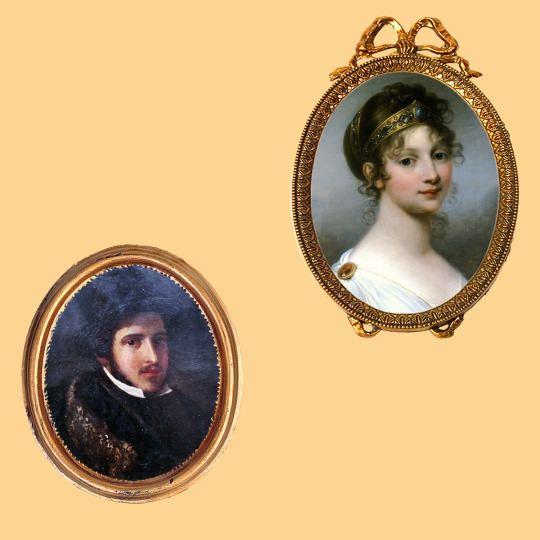
On the right - unidentified artist, miniature portrait of Prince Poniatowski, 19th century. On the left - portrait of Queen Louise by Giuseppe Grassi, 1802.
Prince Józef had the opportunity to meet the wife of the king Frederick William III at least four times, because the royal couple visited Warsaw - which had become a part of Prussia as a result of the third partition of Poland - three times, in 1798, 1802 and 1805. And in 1802 Poniatowski himself had to go to Berlin, to settle the matter of the inheritance left by his uncle Stanisław August.
According to Juliusz Fałkowski, while at Warsaw Prince Józef "…gave a ball and a dinner in the Copper-Roof palace in their honor [the King and Queen of Prussia - A.S.] and was flirting with the Queen everywhere", for which he received the star of the black eagle, although he rather "expected something else from the beautiful queen." After the departure of the royal couple, "he longed a little for the crowned beauty who had easily won his heart in passing."
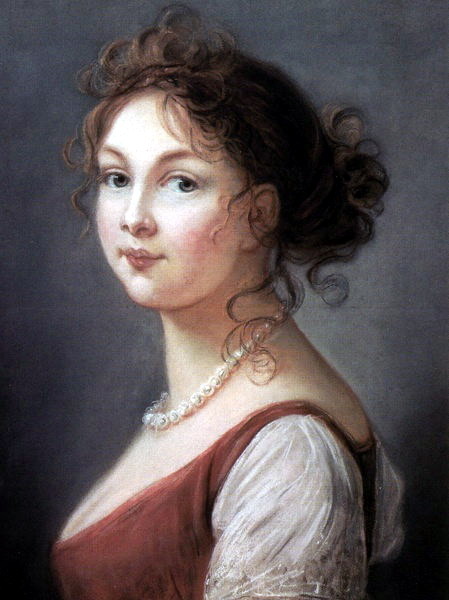
An Elisabeth Vigée-Lebrun painting of Queen Louise, c. 1801
The second source that mentions the relationship between these two is the book by Marian Brandys "Kozietulski i inni", which states (without giving sources, unfortunately) that during Pepi's visit to the capital of Prussia "… it was also said that the beautiful Queen Louise fell in love with in a knightly Pole."
However, if you ask my opinion about the likelihood of an affair between Pepi and the Queen of Prussia, I will say that in my opinion he was "flirting" her to make it easier to solve the inheritance problem. As for the fact that she could also be in love with the prince, I have no opinion because my knowledge about Queen Louise is not very great.
The second lady in today's list will be prince Józef's first cousin once removed, Anetka Potocka (née Tyszkiewicz, the daughter of Konstancja Poniatowska and a grand-daughter of prince Kazimierz, the oldest of the Poniatowski siblings).

On the left - Poniatowski's portrait by Franciszek Paderewski, on the right - Portrait of Anetka Tyszkiewiczówna, Giuseppe Grassi, 1796.
Born in 1779, she was 16 years younger than Pepi, and she remained unmarried for quite a long time, becoming the wife of the Count Aleksander Potocki in 1805. (Marian Brandys, in the biography of Anetka's uncle prince Stanisław, states that some time before 1791 there was an idea to join all the Poniatowski estates marring Stanisław to his niece, but it was eventually abandoned.) The marriage brought them three children, but after 16 years Anetka asked for divorce and then wedded Colonel Stanisław Dunin-Wąsowicz.
During the times of the Duchy of Warsaw, she was a frequent guest at the Copper Roof Palace, visited Paris, witnessed Napoleon's sojourns in Warsaw, with all of those events been described later in her memoirs.
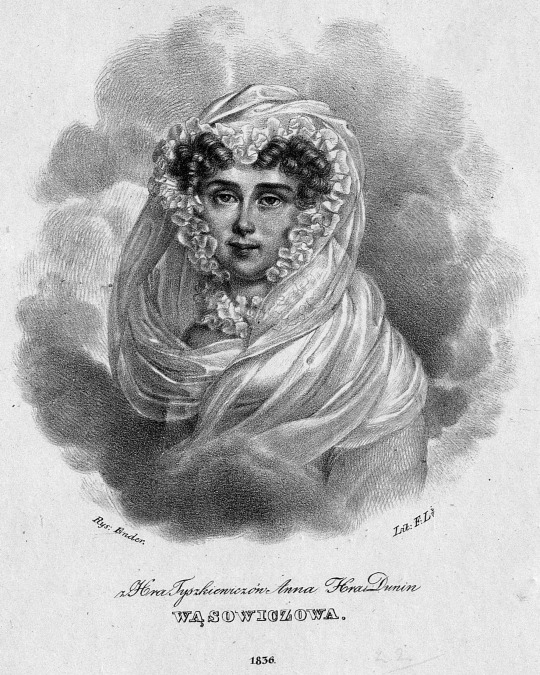
Portrait of Countess Dunin Wąsowicz, Anna née Tyszkiewicz, 1836.
As for her relationship with Prince Józef, it were her own words that made Fałkowski write that "the beautiful prince fell in love with Anetka" although "it was a platonic feeling".
"… Mrs. Aleksandrowa (Anetka Potocka - AS ) herself half-admitted thisin her old age. ''On disait alors que le Prince Joseph avait pour moi un sentiment plus tendre que l'amitié (it was said that Prince Joseph had for me a feeling more tender than friendship),' she would recalled with a dreamy expression on her face."
The second thing that leads historians to believe that Pepi could have distinguished this cousin of his from other relatives is the provision in his will, according to which she was to receive, after the death of the prince's sister, Teresa Tyszkiewicz, his favorite palace in Jabłonna near Warsaw. And when this did happen, Anetka ordered a triumphal arch to be built in the park in memory of Prince Józef.

The palace in Jabłonna, 2019
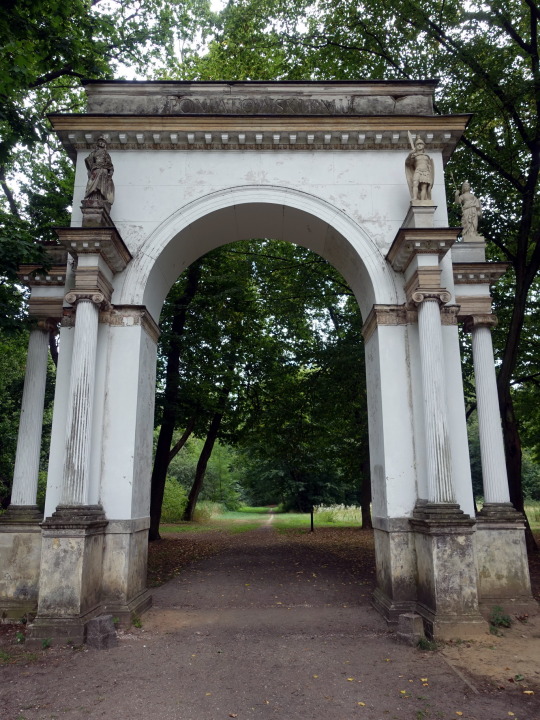
The triumphal arch from Jabłonna's park, 2019
And collage of mine is an illustration to the part dedicated to the rest of the women, whose portraits I wasn't able find. And honestly, the evidence that they might have been Prince Józef's love interests is very weak. But, since historians from time to time do mention these ladies' names, I thought them worth being included as well…
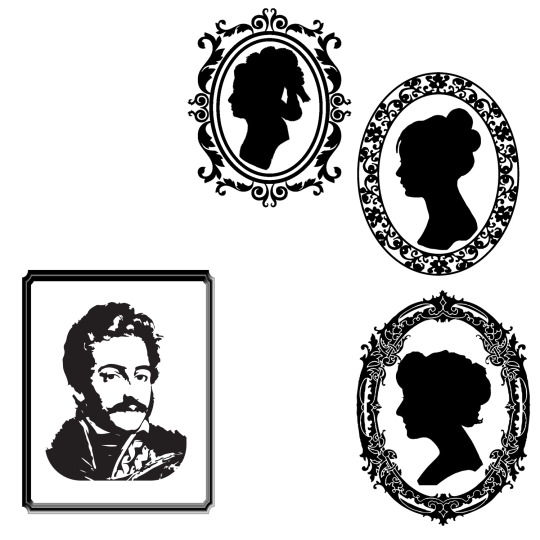
For example, in the prince's testament, together with Henriette de Vauban, Zofia Czosnowska and the above mentioned Anetka Potocka, there was mentioned Elżbieta Merlini, the daughter of Dominique Merlini, an Italian architect, the last main builder of the Polish-Lithuanian Commonwealth. But such concern for the architect's daughter may have been explained by a sense of moral debt to her father, which the prince Józef inherited from King Stanisław with the rest of the things.
Then, the list of Pepi's women sometimes complemented by another "Elżbieta" - Cichocka (although her real names were Emilia Karolina - or Katarzyna) née Bachmińska I° voto Szymanowska, II° voto Cichocka, III° voto Abramowiczowa. It is said she even sojourned in Jabłonna before 1810, until being apparently forced by Zofia Czosnowska to leave the place. After that Madame Cichocka went to Vilna, where she married her third husband. However, what IMHO should be taken into account in regards with this lady is that her second husband, Michał Cichocki, was an illegitimate son of Stanisław August, which might have made Prince Józef consider her a relative and thus take care about.
The same can be said about Madame Kicka - Józefa Martyna Rozalia née Szydłowska, who was a sister of Elżbieta Grabowska, another mistress of King Stanisław.
Sometimes the names of women who were friends and companions of Madame de Vauban are also included to the list of prince Józef's love interests. Those are: Anna Krasińska, a relative of general Krasiński and the wife of Mikołaj Oppeln-Bronikowski; Salomea Wielhorska née Dembińska; Anna Trębicka née Czerska, future wife of general Kamieniecki, and Józefa Potocka née Sollohub.
PS. As the regular visitors to the Copper Roof Palace are as well mentioned two ladies of the surname Walewska: Józefina née Lubomirska, the wife of Adam Walewski and the future wife General Witt, and Maria, the wife of Anastazy Walewski. The first of them was known for her kind of loose behavior, so presumably she might have at least flirted with Pepi; the second one is the famous Maria Walewska, but all I know about her makes me think her love for the emperor left no room in her heart for other men.
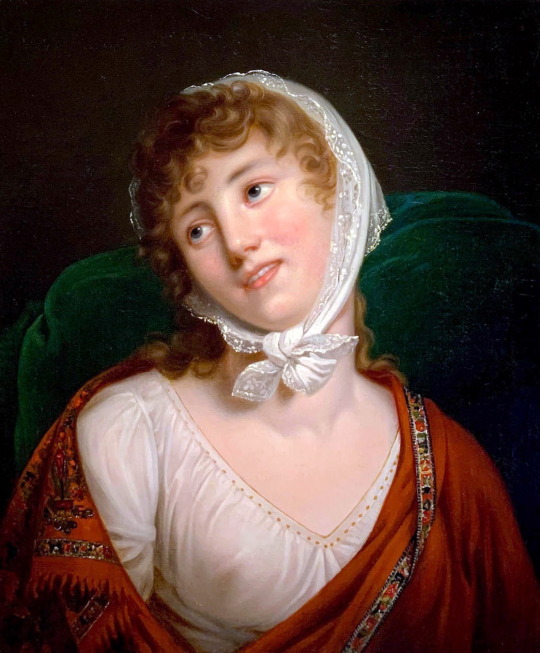
Portrait of Maria Walewska by Robert Lefèvre
#poniatowski#józef poniatowski#józef poniatowski’s women#queen Louise of Prussia#Giuseppe Grassi#Anetka Potocka#Jabłonna#Jabłonna palace#Maria Walewska#Robert Lefèvre
13 notes
·
View notes
Note
Jozef Stanislas Poniatowski (1837-1910) was the son of Charles Maurice Joseph. I read on your site that he died in 1910 in Paris. That's wrong. Six weeks after his marriage with Léonide Charner in 1866 he became mental ill. From 1880 until his death July 20, 1910 in Geel, Belgium, where he resided as a psychiatric patient in the wellknown Geel "Colonie des Aliénés'', where the chief psychiatrist Dr. Edmond Aerts was the grandfather of my grandmother. I found his death act in the Geel official registers where he is named J.S. Prince Poniatowski.
Werner Van den Bergh (Belgium)
Thanks a lot for the information, Werner! I’ve update the post according it.
3 notes
·
View notes
Text
Prince Józef on paintings as a child
Good evening, dear friends, and on occasion of the children’s day let me share paintings where prince Józef Poniatowski is depicted as a child.
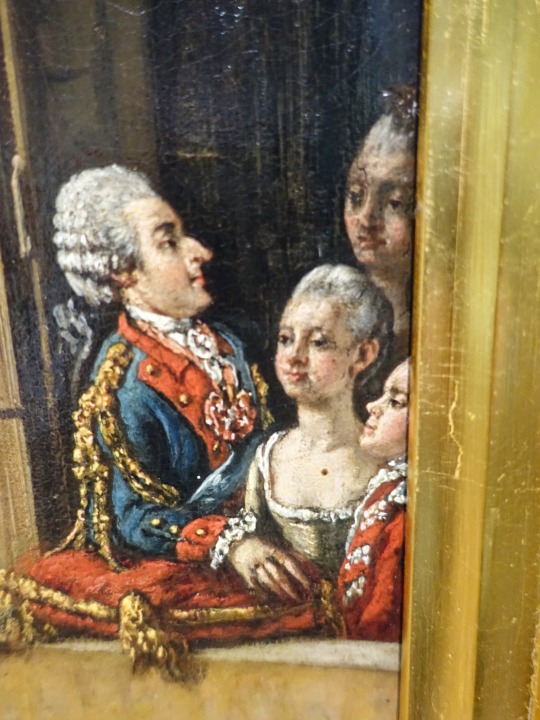
1. Prince Józef, his sister, their mother and the king Stanisław August, a detail of Bernardo Belotto’s image View of Warsaw from the Terrace of the Royal Castle, 1773
The whole painting below, with the group of Poniatowski’s on the right encircled in red:
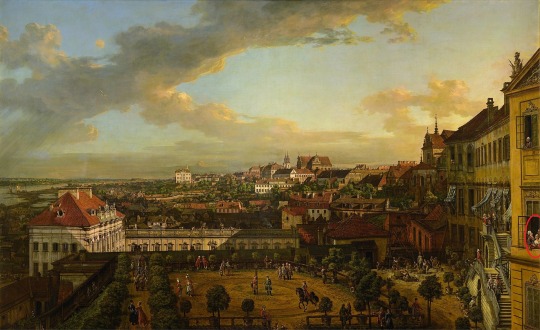
2. Prince Jòzef (in red) and his sister (in green) on horseback, a detail of the painting by same author, named View of Wilanów meadows, 1775:

Whole picture:
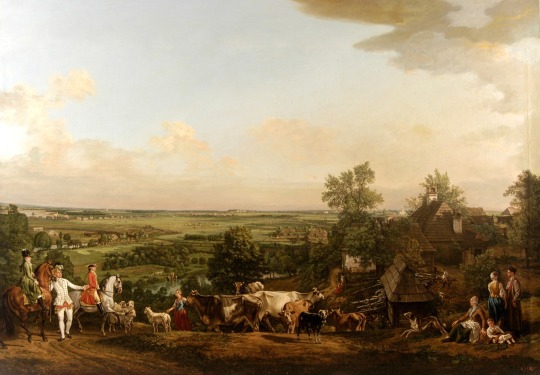
3. Colonel Piotr Königsfels teaching Prince Józef Poniatowski how to ride, an image by Bellotto (again), 1773:
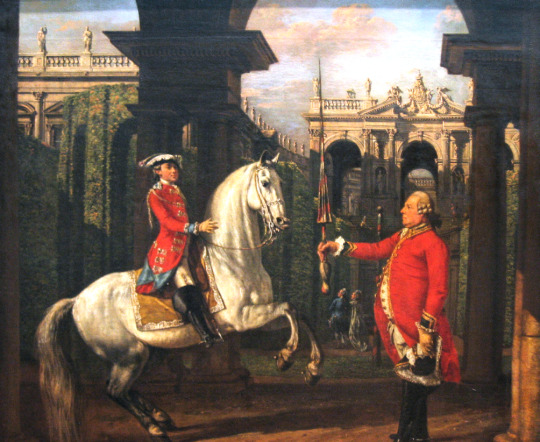
A close-up of Pepi:
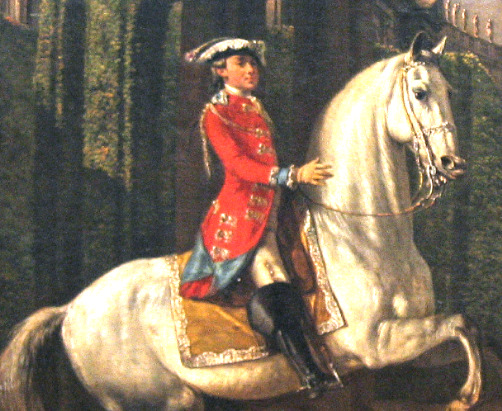
4. A photo of the painting by Marcello Bacciarelli, named Apotheosis of the Parents of Stanislaus Augustus, circa 1768 (the painting itself is, alas, lost during the WWII):
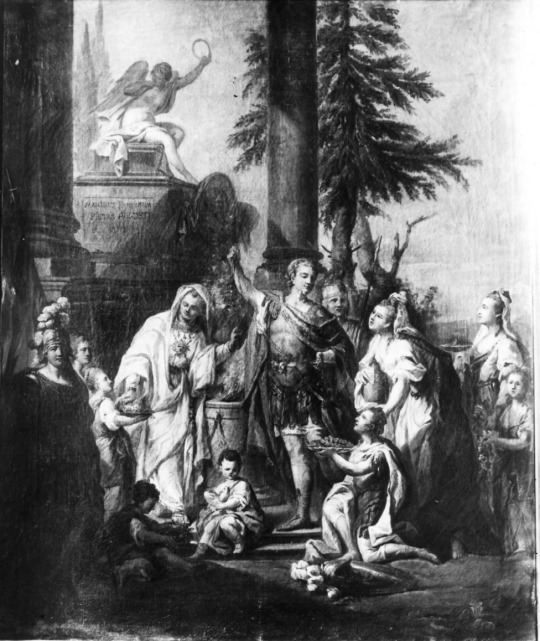
Pepi:

5. And two miniatures by the Pierre Adolf Hall, sold a couple of years ago at Sothebys, signed as Portrait of a young boy, traditionally identified as Prince Joseph Poniatowski:


(They are dated as 1785, but if the model is in fact prince Józef the date should be at least 10 years before)
#poniatowski#józef poniatowski#prince poniatowski#jozef poniatowski#stanisław august poniatowski#bernardo bellotto#marcello bacciarelli#teresa poniatowska#pierre adolf hall
34 notes
·
View notes
Text
Contents of my blog (mainly devoted to prince Józef Poniatowski)
Some posts are re-blogs of my friends’ ones, for them the authors are given in brackets.

(The images added just to draw attention)
Portraits:
On paintings as a child
Painted during his lifetime
The most known posthumous (and its copies)
Other posthumous portraits
19th century “Photoshops”
Sculptures
Not looking like himself:
Engravings etc
With blue eyes
Family album:
Parents and sister
Grandparents, uncles and cousins
Some maternal relatives
Photoshops:
Napoleonic Christmas
Ofelia (by duc_du_orleans from Insta)
Riding naked on the streets of Warsaw
Women trying to seduce him
Relationships:
With women:
Karolina von Thun, Zelia Sitańska, Henriette de Vauban and Zofia Czosnoswka (first love, two mothers of his two sons and a French mistress older than him)
Julia Potocka, Rozalia Lubomirska, Barbara Kossowska (three ladies who tried to seduce him)
Princess Augusta of Saxony (a would-be bride that didn’t happen)
Pauline Bonaparte, Maria of Württemberg, Zofia Zamoyska (women with whom he might have had a kind of “romance”)
Queen Louise of Prussia, Anetka Potocka and the rest (of the names ever mentioned)
Why Poniatowski never married
Poniatowski’s children and descendants
With men:
Napoleon
Murat
Davout (a post of @histoireettralala)
Ligne, Schwarzenberg, Sanguszko, Linowski, Szumlański, Fiszer, Morand, Bignon (pals and comrades)
The Czartoryski family, Talleyrand
Dąbrowski, Zajączek, Sokolnicki, Jérôme Bonaparte (“frenemies”)
Prince Józef’s strong and weak points, quotes etc (a little bit about his personality)
His attitude towards becoming a king
A little bit on the topic of prince Józef’s height
Poniatowski’s favorite horse
Life events:
Place of birth, Vienna
Šabac, 1788
Zieleńce, 1792
Raszyn, 1809
Galician campaign, 1809
Narrow escape from the British Navy when visiting Gdańsk, 1810
Smolensk, 1812
———
Prince Józef’s last year:
Crossing the Berezina river, November 1812
Soldiers’ visit to the Copper-roofed palace, December 1812
Leaving Warsaw for good, February 1813
In Kraków, March-April-beginning of May 1813
Last evening in Kraków, May 1813
Entering Saxony, June 1813
Last summer and September, 1813
The battle of Leipzig, 16th-19th of October, 1813
———
Prince Poniatowski’s death in art
———
How Prince Józef’s body was found, 24th of October, 1813
Literature:
Fiction:
A manga by Riyoko Ikeda (a post by @tairin)
Poetry:
Poetry on the topic of his death
A short story on the topic about events behind his death (mine)
Depiction in movies and on stage:
“The uhlan of prince Joseph”, “The Ashes”, “Prince Józef Poniatowski” and “V.I.P”
Napoleon-Walewska related movies
“The Polish Thermopylae“ (a play)
Documentary videos on YouTube
——————————————————————
Books, magazines and other stuff related to Napoleonic era:
Magazines and some books
Books 1
Books 2
Books 3
Napoleonic era fiction
34 notes
·
View notes
Text
Józef Poniatowski’s women.
Part II. Three ladies who supposedly tried to seduce him.
First of all, I would like to inform you that the story below looks to be a kind of legend. And there is no hard evidence that it really happened. But some diarists recall it in the Memoirs, that is why I thought it is worth to mention.
So, this is said to be happened also, like the episode of “riding naked”, during the Great Sejm. That time Pepi had an affair with the actress “Zelia” Sitańska. But three most beautiful women of that time Warsaw - Julia Potocka, Rozalia Lubomirska and Barbara Kossowska - were not satisfied with the state of things.
So on prince Jozef’s name day they “bribed the butler for letting them into Poniatowski’s bedroom while the latter was absent, decorated his bed with flowers and clothed themselves as Nymphs”. And when the prince eventually returned home, the Copper-Roofed palace („Pałac pod Blachą”), they appeared in front of him in all their beauty.
But this all, as it turned out, was to no avail, because Pepi came not alone, but with his beloved Zelia. Whom he stately refused to abandon, despite all the pleas. So the ladies had to withdraw, being non the wiser (some diarists even mention, that leaving, the women intentionally broke all the nice things they decorated Pepi’s bedroom with).
So, that’s the story. (As I mentioned before, there is no hard evidence it in fact happened. But if it did, and in the time of the Great Sejm, it could not have happened in the Copper-roofed palace, because Pepi didn’t live there yet.)
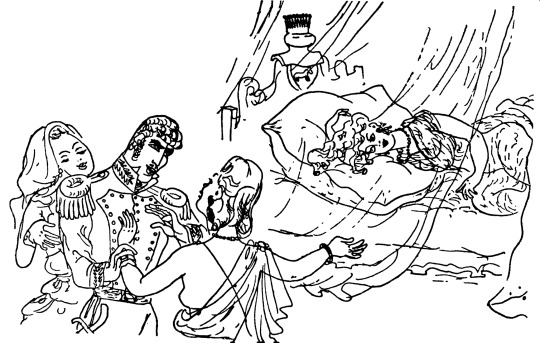
And here is a drawing, showing how this “seduction” might looked like, by Maja Berezowska.

(And, of course, I wasn’t able to resist and made a Photoshop from it, using real portraits of people participated.)
But let’s have a close look to the three Nymphs, who failed to seduce Pepi.
Number one, on the right hand side of my creation - Julia Potocka.

A portrait by Johann Baptist von Lampi the Elder, about 1789
Being born in 1767, she was the eldest of the “Three Nymphs”. Here maiden name was Lubomirska (yes, she was a distant relative of the husband of Rozalia, and, btw, a second cousin to prince Józef).
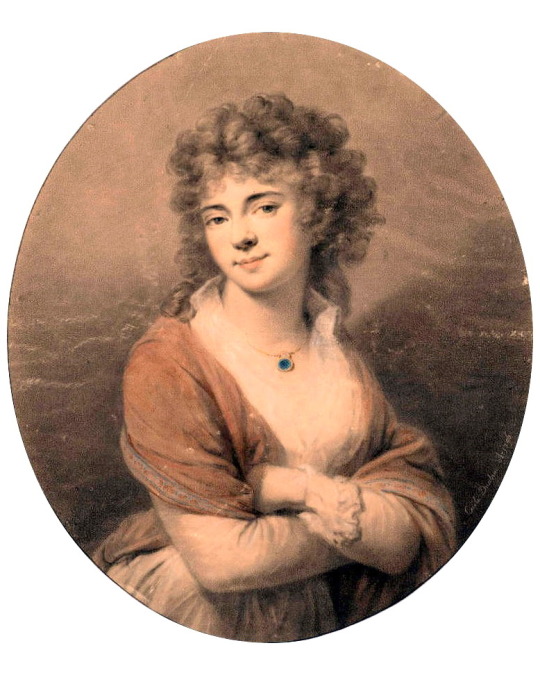
A portrait by unknown author
In 1785 Julia married Jan Potocki (the future author of The Manuscript Found in Saragossa). In two next years their two sons were born.

A portrait by Kazimierz Wojniakowski, 1795
But as for Julia’s feelings towards Poniatowski and her probable participation in the visit - I have great doubts.
Yes, she was considered to be very beautiful (her nickname was “Giulietta la bella”), and everyone was enchanted of how she danced. But together with this Julia Potocka was known a very virtuous woman. Secondly, if there existed a man for whom she could have broken the marital oath it was not Pepi, but his friend, Prince Eustachy Sanguszko.
But the love-story of these two was a very sad one. Several years after the Great Sejm they had to spend abroad, he in Russia and she in France. When they both returned to Poland in 1794 prince Eustachy joined the Kościuszko uprising. And then Julia… died unexpectedly of tuberculosis.
It happened in Krakow, and Eustachy that time was near Warsaw. Having learned about the death of his beloved, he took a vacation under the word of honor. But when he finally got to Krakow, it was too late. The funeral had already started. So the only thing heart-broken Eustachy managed to do later was to get to the tomb with the help of a friendly priest…
The second lady of the trio was Rozalia Lubomirska.

Wincenty de Lesseur: Miniature of Rozalia Lubomirska née Chodkiewicz, between 1794 and 1796 (btw, it was just this image which inspired me to create the Photoshop from the drawing of Maja Berezowska. And something prompts to me the painter as well had seen and been inspired by it )))
Rozalia was a little bit young than Julia, but by 1789 she was also married (to the prince Aleksander Lubomirski) and had a daughter with him.

Anna Rajecka: A girl with a dove, possibly portrait of Rozalia Lubomirska née Chodkiewicz, between 1789 and 1790
Contemporaries remembered the princess Lubomirska as a beauty, with a filigree figure, golden blonde hair and blue eyes. But here participation in Pepi’s seduction either doesn’t seem to look probable.
Because in the summer of 1788 Rozalia left with her husband for Paris, and prince Józef came to Poland from Austria to Poland only in autumn of that year. And when two years later she return to Warsaw she fall in love with another man. His name was Tadeusz Mostowski and it looked like he reciprocated her feelings.
In the fall of 1792, they left for Switzerland almost simultaneously. And a year later, when he had to go France on a diplomatic mission, she followed him.
But during the next year their feelings, it looks like, that faded away. And when in autumn of 1793 Mostowski left Paris, princess Lubomirska decided to stay there alone. And was arrested.
The next six months she spent in prison. Of course, there were some efforts to free her. Made by Mostowski and others. But to no avail. It was said that Robespierre himself had fallen in love with Rozalia, but had been rejected, and for that very reason he was relentless.
Anyway, in June 1794 princess Lubomirska was executed…
So, let’s move to the last “participant” of the visit, Barbara Kossowska.

Portrait of Barbara Kossowska née Belińska, ab. 1800, by an unknown painter.
She was the youngest of the trio, being born in 1770 (though in some sources her birthdate is stated as 10 years before). She was also married, to a man 20 (or even more) years older than her.
And she was the only one of the three, who might have paid a visit to prince Poniatowski to the Copper-roofed palace, because in 1798, when he moved there, she, in comparison with Julia Potocka and Rozalia Lubomirska, was still alive. The diarists recalled how she drew everyone's attention while dancing with Pepi on the balls he arranged.
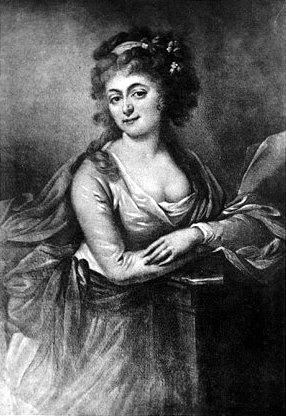
Portrait of Barbara Kossowska née Belińska, Johann Baptist von Lampi the Elder, 18th century
But even Barbara was not predestined to live long. She died in 1801. It is not known what exactly happened and with whom of her four children, but it looks like she gave her life saving one of them. Because the inscription on her tombstone in Powązki cemetery stated: "This grave hides the body of a virtuous mother, saving the lives of children, she has lost hers".
I am sorry, but the story of third “Nymph” turned out to be sad as well…
And this post was supposed to be a fun.

So, to sweeten it up I decided to add one more Photoshop (or, more exactly, the extended version of the first one). Here you can see not only the seducers but Pepi’s sweetheart Zelia as well. And as background I added in image of prince Józef’s bedroom from Myślewicki palace of the Royal Bath (Łazienki) park, which was his home in the times of the Great Sejm.
#józef poniatowski#józef poniatowski’s women#zelia sitańska#julia potocka#rozalia lubomirska#barbara kossowska#photoshop
30 notes
·
View notes
Text
Why Józef Poniatowski never married
“A man with a reputation of a womanizer, with a couple of illegitimate children - and not married? Why so?” Knowing my interest in prince Poniatowski different people from time to time ask me these questions. So I decided to write this post to clarify the issue.
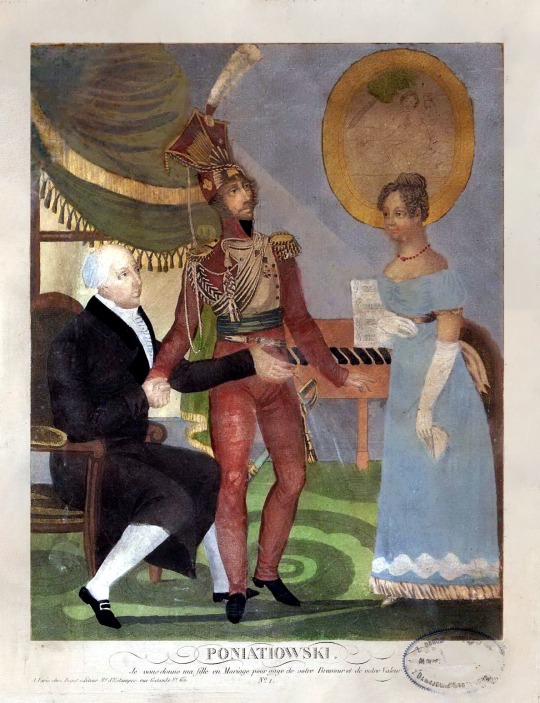
Prince Józef making a proposal, an engraving by F. Begat, 1821, from a French aquatint series illustrating Poniatowski’s life and death events - a completely imaginary, but the best illustration combining both the topics of “Poniatowski” and “marriage” I was able to find.
And to understand why Pepi remained a bachelor to the end of his days we need to have a look at his whole life, starting from the younger years.
Because when prince Poniatowski was in his twenties he did want to marry, to make his first love, the Austrian countess Karolina von Thun, his wedded wife.

Maria Carolina Anna von Thun, miniature brush by Anna Hochstädt (based on the original by Friedrich Heinrich Füger).
But, as I wrote in the post dedicated to prince Józef’s women, Pepi’s uncle, the Polish king, didn’t allow the nephew to associate himself with a girl of his choice. So, in the first case Poniatowski didn’t marry because he was prohibited to.
Furthermore, the king had his own ideas on which families it would have been convenient to become related with ordering prince Józef’s hands to their daughters. Among them there were a couple of cousins Czartoryskis (Maria and her younger sister, Zofia). Then Krystyna - the daughter of Ignacy Potocki. And one more girl - from Rzewuski family etc. (But all these projects remained on paper, and I am not even sure whether Józef knew about them.)
Anyway, the pressing of necessity to obey his uncle-king in matrimonial matters remained with prince Józef at least until Stanisław’s August abdication in 1795 (if not till 1798, when the latter died). And Pepi was finally “free” his first love wasn’t free anymore.

Élisabeth Vigée Le Brun, portrait of Lady Gillford, nee Marie Caroline von Thun, ci. 1792-95.
Yes, in 1793 the countess von Thun became the wife of a British diplomat, lord Gillford.
And approximately at the same time in Pepi’s life there appeared another lady, a Frenchwoman named Henriette de Vauban.

Felicja Pichor-Śliwicka as Henriette de Vauban and Józef Węgrzyn as Józef Poniatowski in Jan Adolf Hertz’s play “Prince Jozef Poniatowski”
First she accompanied prince Józef and his sister during their travel around Europe. And later, when in 1798 Poniatowski settled down in Warsaw, Madame de Vauban not only moved together with him into his famous palace “Pod Blachą” but quickly took on herself responsibilities of the “hostess”.

An unknown painter, a miniature portrait of Henriette de Vauban, ci. 1789
And the presence of Henriette in prince Józef’s life is thought by French (and even some Polish) historians to be a reason of Poniatowski’s indisposition to “tie the knot”.
Yes, being from 1798 to 1806 a Prussian subject and a private person Poniatowski theoretically could propose whoever he wanted. But Madame de Vauban was, from one hand, already married. And, from the other hand, she was giving prince Józef enough comfort not to seek consolation in a marriage with another woman.
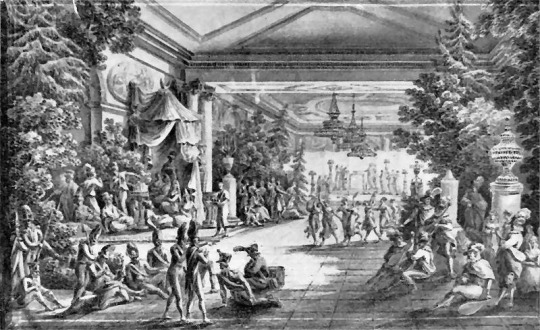
The feast arranged on occasion of prince Jozef’s birthday in the former royal library at the castle in Warsaw, Zygmunt Vogel, 1808
So it may be stated that prince Józef didn’t marry Madame de Vauban because she wasn’t eligible, and didn’t choose any other woman because he didn’t want to.
Ok, you may ask, and what about Zofia Czosnowska, the woman who gave birth to Poniatowski’s second son?
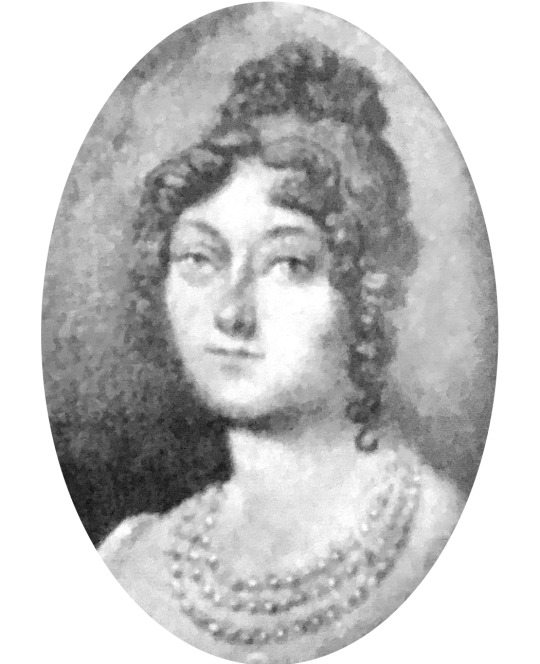
An unknown painter, a miniature portrait of Zofia Czosnowska
Considering this lady we first need to keep in mind that she herself was also married. (And though she separated from her first husband even before she became Pepi’s mistress, their formal divorce happened much after Poniatowski’s death, she during the time of his life Zofia Czosnowska wasn’t free either.)
An aside I couldn’t help but write: with all Pepi’s feelings towards beautiful Zofia, her appearance in his life didn’t change prince Józef’s lifestyle. As if nothing had happened Henriette de Vauban continued to live in Poniatowski’s house, prince Józef mentioned her in his will of 1812, and even shortly before his death he is recalled to say that “When it comes to dying ... to the afterlife I will take with me the unearthly smile of Henrietta ...”. All this IMHO eloquently says whom he really was attached to.
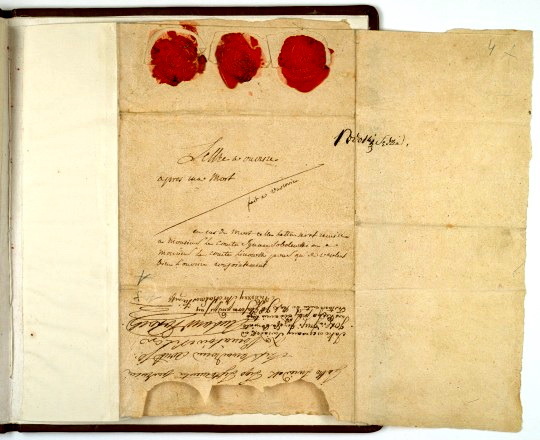
Poniatowski’s will
And there is one more thing we should take into account when looking at prince Józef’s later years. Namely - the creation in 1807 the Duchy of Warsaw.

Napoleon issuing the Constitution of the Duchy of Warsaw by Marcello Bacciarelli (1811)
Because this event, definitely positive for prince Józef’s motherland, simultaneously turned him from a private person to a public one, with all the consequences. And though Napoleonic code, from one hand, allowed divorces, the emperor, on the other hand, preferred to arrange marriages to his people by himself. Which means that had prince Józef acquired a desire to marry a woman he liked he first should have persuaded Napoleon to approve such a choice. And this again put Poniatowski in a kinda gloomy state like it had been years ago when he was dependent on the wishes of his monarch. And this fact may in my opinion served an explanation if to ask why Pepi didn’t divorce one of his mistresses from her husband and marry her...
And the last but not the least. Yes, by many people prince Józef is thought to have be a womanizer, but the more I learn about him the am I becoming convinced, that this might been a kind of “exaggeration”.
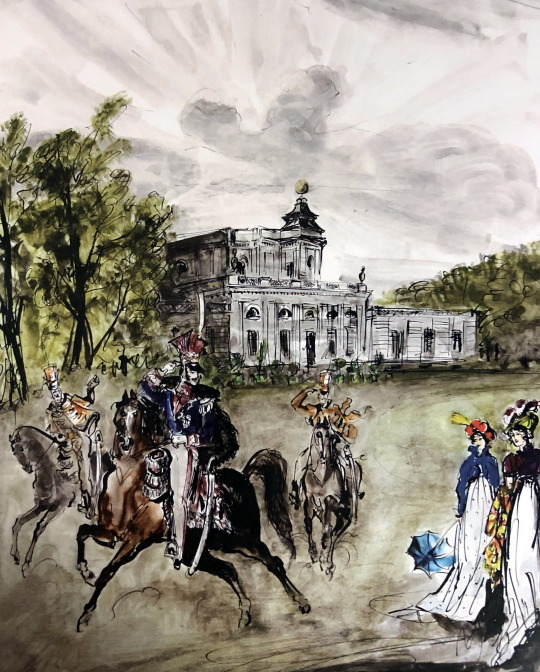
Antoni Uniechowski, prince Józef Poniatowski in Jabłonna, 1975
Because many a diarists recall that “he liked women, and women liked him”, but precise names are rarely mentioned, and if to count the ones of Poniatowski’s proven “love interests” the number is in fact not very high (especially to compare with such known “ladies' man” from the epoch like Napoleon, Talleyrand, Murat etc..)
#Poniatowski#józef poniatowski#józef poniatowski’s women#henriette de vauban#zofia czosnowska#karolina von thun
14 notes
·
View notes
Text
Józef Poniatowski’s family album.
Part II. Grandparents, uncles, cousins (or 3 Stanisławs, 2 Konstncjas, Kazimierz and Michał )))
This week let’s continue talking about prince Józef relatives. In the previous post on the topic I wrote (and showed portraits) of Pepi’s parents and sister. So today there will be images and some information about others.
Let’s start with the grandparents. (Unfortunately, I wasn’t able to find much about Poniatowski’s maternal ancestors, so this post will be about relatives from his father's side...)
This fancy gentleman is the father of prince Anrdzej and the progenitor of the family - Stanisław Poniatowski.
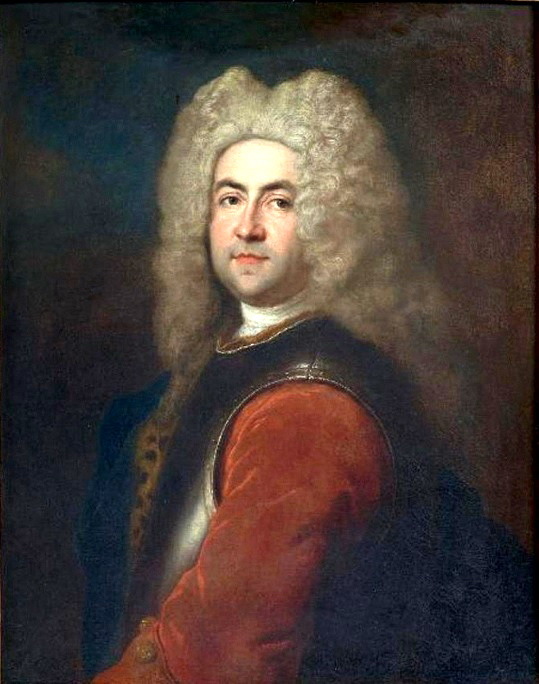
Portrait of Stanisław Poniatowski, unknown painter, 18th century
He was born in 1676, as a son of a petty nobleman from Lesser Poland. And died in 1762, having achieved the highest rank possible for a civil servants in the Polish-Lithuanian commonwealth - the castellan of Kraków. (Speaking in modern terms Stanisław Poniatowski can be called a self-made man.)
Of course, the life of such a man was full of ups and downs. That is why telling you about him I would like to focus only on things, which IMHO had some similarities with the destiny of Stanisłasw’s grandson, prince Józef.
During the Great Northern War Stanisław took the side of the Swedish king Charles XII and the latter’s protégé - as a king of Poland - Stanisław Leszczyński. (On the other side there were Peter The First of Russia and August II of Saxony, who had been elected as a Polish king.)
To the misfortune of the first party, one of the decisive battles of that war, the one Poltava in 1709, was lost, but this wasn’t a reason for Poniatowski to turn his back on Charles. On the contrary, Stanisław then saved life of his suzerain, and after that help him to flee to Turkey. And remained faithful the Swedidh king to the very end, till Charles’ death 10 years later. (Although for this reason Stanisław had to spend all these years abroad, taking care of various matters of the latter.)
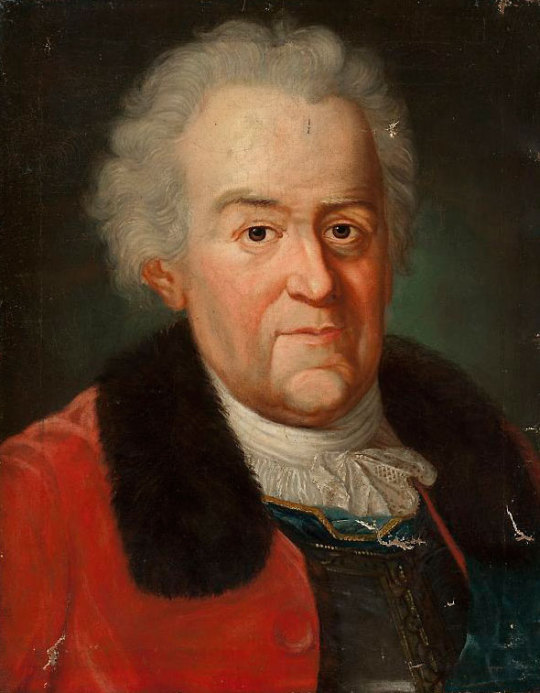
Marcello Bacciarelli, Portrait of Stanisław Poniatowski, after 1758, National Museum in Warsaw
And only after Charles passing away, Poniatowski went to Poland and asked pardon from August II. And having received it, remaining a faithful servant of that ruler till the Saxon king’s death in 1732.
During the next interregnum, however, Stanisław supported again the candidacy of Stanisław Leszczyński, the former protégé of Charles II. And only under the pressure of circumstances (one of his youngest sons, his namesake Stanisław, the future last king of Poland, was kidnapped by the adversaries of the opposite, Saxon party, to forced Poniatowski to join them) he switched sides.
As for Stanisław’s private life - it was also not without complications. In 1710 he married Teresa Jasieniecka, a widow of a Lithuanian nobleman Ogiński. But shortly the wedding it turned out that Teresa’s financial state was not so well as expected, instead of money she possessed debts only. And it looks like it was the reason for Poniatowski to leave her. (Some sources even say that the couple eventually divorced).
Anyway, whatever happened with Teresa later, in 1720 Stanisław seemed to be eligible again, because that very year he married again, this time to Konstancja Czartoryska.
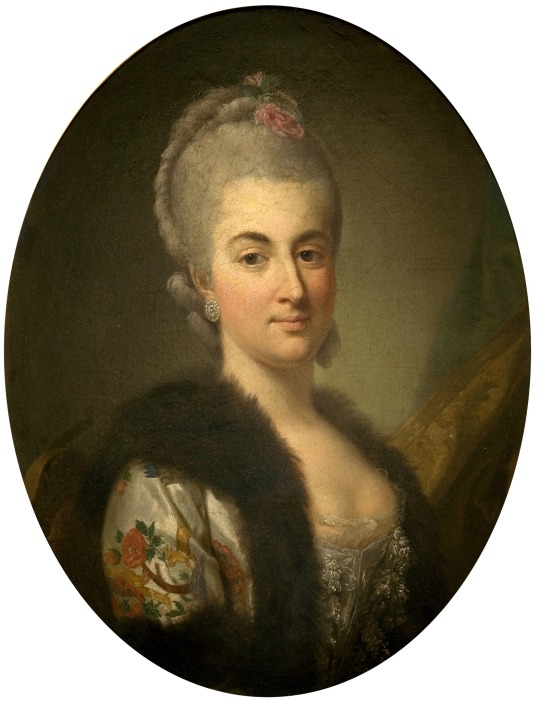
Per Krafft the Elder: Portrait of Konstancja Czartoryska, circa 1768, National Museum Kraków
Being born circa 1700 Konstancja was about 20-25 years younger than Stanisław’s, but this didn’t prevent the the marriage from being successful. The reason might have been that, though for Poniatowski this was again a kinda “strategic marriage” (because the Czartoryski family was very powerful), the bride was really in love with her groom. To such an extent that she married him despite her father’s will.

Marcello Bacciarelli, Portrait of Konstancja Czartoryska, 18th century
And, in general, Konstancja was so stubborn and willful, that in the family she was called “Chmura gradowa” (hail cloud).
As an example of her adherence to principles there might be recalled the story of her son Kazimierz duel with Adam Tarło. First she forced Kazimierz to challenge Tarło - though even by the standards of that time the reason doesn’t seem justified enough. An then, when the shooting happened with no harm to both sides and young men reconciled, the mother made the son to challenge his former adversary twice. And that time the duel ended with a death, fortunately to her - not of her son.
And such a story was not a unique one. (And something prompts me that had Konstancja been alive in 1761, when her son Andrzej, prince Józef’s future father, was about to marry a Czech noblewoman Teresa Kinska, the princess Poniatowska might not have agreed to that union. But the latter died already in 1758, so it wasn’t hard for Andrzej to get agreement from his very old and ailing father...)
Now, let us move to the next generation of Poniatowskis. The most known of them (and who, btw, was the favorite son of his mother) is Stanisław Antoni. Because in 1763 he was elected to become the king of the Polish-Lithuanian commonwealth (and, ascending the throne, changed his second name to “August”).
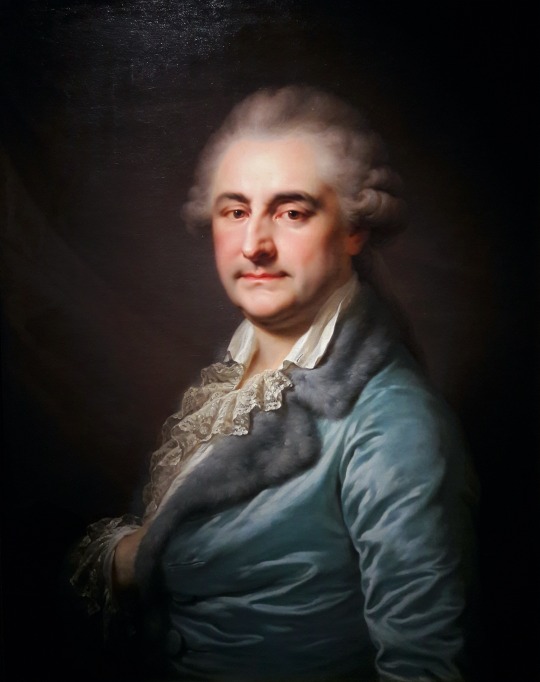
Johann Baptist von Lampi the Elder: Portrait of Stanislaus Augustus in a dressing-gown, between 1788 and 1789, National Museum in Warsaw
Do you remember that the second name of prince Józef was “Antoni”? Yes, he got it in honor of that uncle of his!
And later Stanisław August had a lot of influence on his nephew, taking care on young Pepi and his older sister Teresa after their father’s death in 1773.
But in my opinion it won’t be correct to call prince Józef the favorite of king Stanisław, the person whom the latter saw as his possible successor on the Polish throne. Why? Because there also was the oldest of Stanisław’s siblings children, the son of the above mentioned Kazimierz and the king’s namesake - one more Stanisław. (More about him - a little bit below.) And only for the short period from 1791, when that Stanisław withdrew from public life and emigrated to Italy, till 1795 Pepi’s candidature might have seriously been seemed as a possible royal successor.
Ok, now let’s look at Kazimierz. In addition to participating in that infamous duel the oldest of survived sons of the Poniatowskis was known for leading a rather riotous life. Having married a wealthy bride Apolonia Ustrzycka he had a lot of money and spent them freely and sometimes rather eccentrically. In his greenhouses, for example, there were grown... pineapples! And he also brought to Poland from Africa a bunch of monkeys (though all they died shortly because of the cold Polish climate (( )
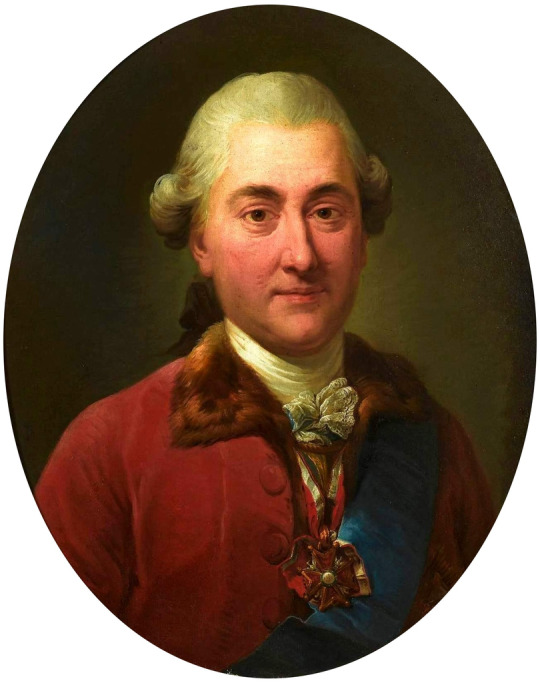
Unidentified painter, Portrait of Kazimierz Poniatowski, second half of 18th century, Palace Museum in Wilanów
In his private life prince Kazimierz was also a real child of his time - he had several mistresses. And one of them he even drove around Warsaw naked - so that everyone could "see" her charms. (You see, prince Józef had people among his uncles to take examples from ))) And I must also mention, that Kazimierz had a loving affection for his nephew. And in the last decade of the 18th century, when Pepi was already living in Warsaw, the uncle willingly invited the nephew to his place and even supported him financially.
And despite that notorious style of life prince Kazimierz outlived all his younger brothers and died in 1800, being almost 80 years old.
And now a little bit information about Michał, the youngest of prince Józef uncles. He was destined by his parents for the clergy, and in the church hierarchy he “climbed” to the highest Polish rank - the Primate of Poland. (Though, as many sources state, prince Michal was a priest just in the spirit of his age - having mistresses and possible even illegitimate children.)

Marcello Bacciarelli, Portret of Michał Jerzy Poniatowski, National Museum in Poznań, 18th century
And the circumstances of his death in 1794, in the age of 57 years only, still aren’t clear enough. That was the time, as you may remember, of Kościuszko’s Uprising, and Michał was among supporters of the king and the latter’s pro-Russian politics. So, when the primate became seriosly ill and then died there appeared rumors, that that might have been a suicide, in fear for being hanged, as those members of Targowica Confederation who weren’t lucky to flee.
In relation with prince Józef I can name only one significant thing of Michał’s biography - it was who from him Pepi inherited Jabłonna village under Warsaw with its famous palace.
For the record I should also mention that the Poniatowskis-senior had also 2 daughters, Ludwika Maria and Izabela, but they didn’t seem to play significant roles in their nephew’s life.
And now let’s look at the third generation - Pepi’s cousins, children of prince Kazimierz.
This is the very prince Stanisław, whom I mentioned above:
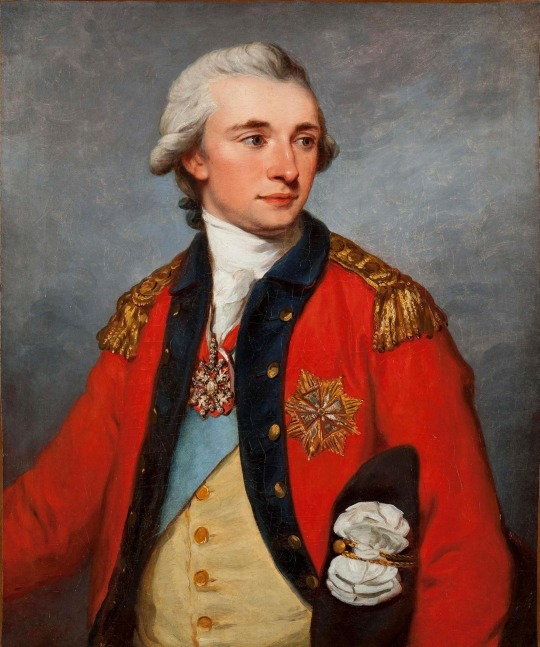
Angelica Kauffman, Portrait of Stanisław Poniatowski (1754-1833), 1786
Very well educated and economically talented, he carried out a lot of reforms in his vast estates in Ukraine, and made these land prosper. Being interested in art, he founded a painting school in Warsaw. More than once a member of the Sejm, elected marshal of the knighthood of the Permanent Council, member of the confederation of the Four-Year Sejm and... not a popular figure among the the nobility (szlachta).
Because of the latter reason in 1790 there arose a conflict between prince Stanisław and his adversaries, after which the prince resigned from all his post and abroad.
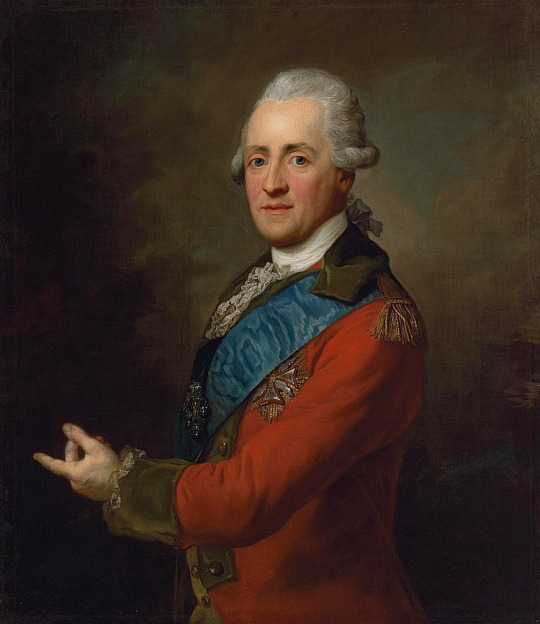
Portrait of Stanisław Poniatowski (1754–1833), attributed to Johann Baptist von Lampi the Elder, 18th century
He settled in Italy, where he owned estates, and unlike his cousin Józef, never returned to public life.
As for Stanisław’s private life - well, it also looked like a suitable plot for a romance novel. The prince met his future wife in Rome, when he was already in his fifties. She was thirty years younger than him and... a wife of his neighbor.
Her name was Cassandra Luci, and she was a common woman, beaten by her cruel husband. And one day, trying escape from an attack, she knocked on prince Poniatowski’s door, was allowed to enter his residence, and stayed with the latter forever.
First, of course, Cassandra served in Stanisław’s residence just as servant, becoming the housekeeper. But soon she answered his feelings, and... by 1816 the couple had already 5 children - 2 sons and 3 daughters. And when in 1830 Cassandra’s husband died, Stanisław was finally able to marry her.
And all the Poniatowskis living now in France are descendants of this couple. Or, to be more precise, of their second son Joseph Michael.
Relating to prince Józef - it looks like his cousin Stanisław didn’t have much affection on him. They met a couple of times before Pepi moved to Warsaw in 1788, definitely had chances to see each other between that time and the year when Stanisław emigrated, but that’s all. And much more close prince Józef was with his other “probably” cousins - the sons of king’s mistress, Elżbieta Grabowska. (But this definitely goes out the topic of this post.)
So, let’s move to the last person of today’s article, prince Stanisław’s younger sister princess Konstancja.
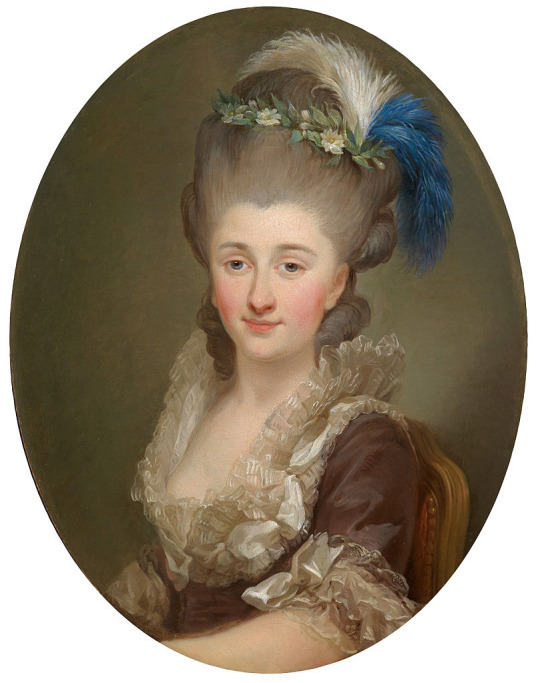
Marcello Bacciarelli, Portrait of Konstancja Tyszkiewicz, nee princess Poniatowska, circa 1775
And, I have to admit, she didn’t play any significant role in Pepi’s life either. (Though her daughter, Anetka, might have had - but about the latter I will write later, when the time comes to publish next post of prince Józef women.) But the reason I am writing about this Konstancja now is that her husband’s surname was Tyszkiewicz, just like the surname of the Pepi’s sister Teresa’s husband.
If you ask me whether those two Tyszkiewiczs were relative, I would answer you that they were very distant ones, because last common ancestor was the progenitor of the Tyszkiewicz family, named Tyszka, who lived in the 15th century.
As for why the king decided to marry both his nieces to the Tyszkiewicz family - on this question I don’t either have an answer. But I can quote you a verse which was written in Poland that time:
Tyszkiewicza
Król policzą
Między bliskich swoje
Dał jednemu
Dał drugiemu
Swych synowic dwoje
(Translation: The king counts the Tyszkiewiczs among his relatives, he gave to one of them and to another two of his nieces)
And because of these two Tyszkiewiczs, and the fact that Anetka Potocka née Tyszkiewicz is sometimes called prince Józef’s niece (though in fact they were first cousins once removed) Teresa Poniatowska, Pepi’s sister is, in these cases, called her mother, which is not at all true. And eery time I write such a statement it that makes me cringe. That is why I felt I ought to write about Konstancja, for the people know that there was one more Mrs. Tyszkiewicz, and that she was Anetka’s real mother.
Well, that’s all for today. and I hope I didn’t make you much tires with untangling all these family ties? ))
#józef poniatowski#the poniatowskis#poniatowski#stanisław poniatowski#stanisław august poniatowski#polish history#konstancja poniatowska#kazimierz poniatowski#michał poniatowski
6 notes
·
View notes
Text
Józef Poniatowski’s family album
Part I. Parents and sister
Because in one of the previous posts I touched a little bit the topic of prince Józef relatives (closest and more distant ones) let’s now talk (and look at portraits) of his family.
To start I would like with his parents and sister.
Pepi’s father, Andrzej Poniatowski, was the penultimate son of Stanisław Poniatowski, the castellan of Kraków. He was born in 1734 in Gdańsk, where the Poniatowski’s resided during the time of the War of the Polish succession.
Having chosen the military career Andrzej had to join the Austrian Army, where he reach the ranks of general and then field-marshal.
Unfortunately, not very many portraits of prince Józef’s father survived till our days (maybe because of his early death, in 1773). So I was able to find only these two (which, withal, look like copies of each other):


Left: by unknown French painter, circa 1750-1775. Right: a copy from a pastel attributed to Louis Marteau, before 1770
Now let’s switch prince Józef’s mother. Of her portraits, fortunately, to our-days survived more.
Her name was Teresa Maria Herula countess Kinsky von Weichnitz und Tettau and she was 6 years younger than Andrzej.

A portrait of princess Poniatowska made by unknown author, circa 1770
Teresa Herula met her future husband in Vienna, and everything indicates that their union was a love marriage. (Or, at least, that Andrzej had some feelings for the countess von Kinski, because it was he himself who chose her as his wife to be, though the Kinsky’s were not very rich that time.)

A miniature portrait by unknown author.
After the wedding the Poniatowski’s stayed to live in Vienna, where both of their children, the oldest - daughter, and the youngest - son were born. But during Andrzej’s life they visited Poland several times.

Per Krafft the Elder, Portrait of Teresa Kinsky von Weichnitz und Tettau, 1767
However, though, as I wrote above, Poniatowski’s marriage was a love-match there were facts that might have indicated that not everything was fine between these two.
First, it might have been that Andrzej had an illegitimate son. At least, some diarists of that time thought that a person named Michał Michałowski was mentioned in prince Józef’s will not without a reason, that Michał was in fact Pepi’s half-brother.

Per Krafft the Elder, Countess Teresa Kinska Poniatowska, 1765
Ok, having children out of wedlock was kinda ok that times. But in one book I read that Teresa Herula, in her turn, also cheated on her husband. With Nickolay Repnin, that time Russian ambassador in Warsaw. (However, I wasn’t able the source of that statement so I am not sure whether we should believe it.)

Pierre-Joseph Lion, Teresa Poniatowska née Kinska, 1764 (Doesn’t it seem to you that this portrait of her looks like a pair to the second one of Andrzej?)
And what happened with Teresa Herula after Andrzej died? When she widowed the princess Poniatowska was only 30… But she never remarried again. And during her later life preferred to stay in Austria, where her family had real estates. And died in 1806, just a couple of month before Napoleon’s entrance to Warsaw, which brought so significant changes in her son’s life.
Ok, and now let’s look at portraits of Teresa the youngest. (As for her biography details - I mentioned a lot of them in one of the previous posts, so with your permission I’ll skip them this time. The most known portrait of the countess Tyszkiewicz can also be found there.

Maria Teresa Poniatowska as a teenager, unknown author

Fryderyk Dubois, Portrait of Maria Teresa Tyszkiewicz née Poniatowska, circa 1785

Portrait of Maria Teresa Tyszkiewicz, the 18th century miniature
4 notes
·
View notes